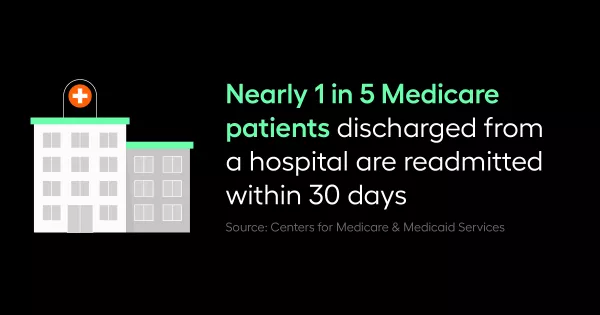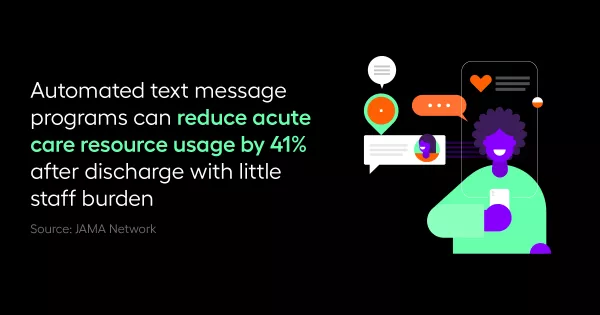Unlock population health with transitional care management
In the first 30 days after patient discharge, transitional care management can transform outcomes
When a patient is discharged, the clock starts. 30 days—the critical amount of time where patients have a higher risk of readmission.

Transitional Care Management (TCM) aims to provide patients with the proper care during this time and can reduce readmission by as much as 86%. TCM relies on a strong foundation of data for its success, but not every health system has the technical resources at their fingertips required to measure and improve TCM metrics.
AMITA Health Care Network, a clinically integrated network (CIN) in Illinois, is an example of an organization that has had success at TCM. It reduced readmission rates without access to a technical team trained in SQL and data analytics.
Andrea Purjue, Director of Enterprise Solutions at Arcadia, Jake Hochberg, Executive Director of Customer Insights at Arcadia, and Michele Winiarz, System Director Quality and Patient Safety, Population Health at AMITA Health Care Network discussed its approach as well as the benefits and challenge of TCM in Arcadia’s webinar, Success in Transitional Care Management: How AMITA Health measures TCM to improve population health outcomes.
Winiarz identified a few reasons TCM has benefited her organization.
“Our CIN covers over 400,000 lives in a very large geographical area, spreading across over 10 different hospital systems. And so TCM really has been instrumental in helping patients navigate through our health system efficiently,” she explained. “It has also been very important to improve our in-network utilization and also reduce our readmissions.”

Hochberg noted that the short time after discharge can be racked with cost, so in addition to supporting patients, TCM brings cost savings to the organization.
“For a bulk of patients, the time you're going to have the most medical spend is either during an inpatient admission or in the window after an inpatient admission,” he said. “So there's a lot of opportunities for cost reduction and outcome improvement in that small window after a patient is discharged.”
How to use transitional care management to drive better outcomes
To achieve the outcomes of better patient navigation of the system, reduce medical expenses, reduced readmissions, and a shift in care from the in-patient to the out-patient setting, Hochberg advises organizations to do two important things.
First, choose the right patient group (usually this would be high-risk patients).
“Identify the right patients for managing that transition, identifying the right provider partners, so you can drive engagement through that group,” he said.
Second, help primary care practitioners understand why the program is important and how it benefits them.
“A lot of it is helping PCPs understand why it is important. What outcomes does it drive? And also, what value can it bring back to you as a PCP because providers do get incentivized to do Transitional Care Management visits, they get to bill at a higher rate,” he continued. “But more importantly, they build a better engagement with their patients, the patients come back more often, so if you're seeing your patients after that transition, not only are you helping keep them out of the hospital, you're building a better relationship with your patient population.”
Winiarz thinks data is the key to bringing providers on board with TCM’s value. She uses it as the cornerstone of her provider education.
“It’s really just showing them their individual data and it's been so useful,” she shared. “I mean so many physicians are visual so to be able to show them a bar graph, it just sinks in and see that flow from no TCM to a readmission to the to the additional cost and that’s so important in our ACO utilization and also with our Medicare Advantage lives.
5 challenges to running a great transitional care management program
Establishing a strong TCM program isn’t ever a walk in the park. Many organizations have found they need to find solutions for common problems.
1. Engaging patients (why it matters, why it’s a challenge to get them to come in for visits)
Many providers find it’s hard to get patients to come in for a post-discharge visit.
2. Many moving pieces in large networks
In large provider networks, things get complex quickly and there can be overlap in roles that create duplicate efforts and potentially annoy patients rather than help as well as slower response times. To move quickly, democratization of data is necessary.
“There’s an element of seeing data, seeing a trend, and having the right person be enabled and empowered to chase it down. So I think unlocking and democratizing your data across your company can go a really long way, in terms of empowering the right people to identify those issues and drive to a real resolution,” said Hochberg.
3. IT infrastructure
Often providers don’t have the IT infrastructure in place to efficiently process TCM patients in the tight time window required. Tight budgets, staff burnout, or attrition can make it nearly impossible to build out the tools. Usually, it’s the independent practices that have the biggest challenge with IT connections.
Both Winiarz and Hochberg say these challenges with independent practices are due to most of them being on separate networks and maining separate appointment scheduling systems. This limits and slows communication of the data required to engage TCM patients.
“That's really a challenge you'd hurdle is building that telemetry so that you can centralize the outreach and centralize the appointment scheduling for providers,” Hochberg said.
4. General staffing and physician burnout
Like many areas of care delivery, post-pandemic provider burnout and staffing shortages lead to extensive issues for TMC. There are not enough providers to handle the needs of every discharged patient. Fewer, more exhausted, providers means less time in the schedule to fit in in-person visits within the short 7-14-day time window.
Winiarz hears this as a common refrain regularly.

“For those providers that aren't doing or utilizing TCM visits to their advantage, I hear the same two things; staffing resources, and they just don't have the time,” she said. “In our market, we've had a reduction in our PCP footprint post-pandemic, and a lot of offices have lost a PCP or two and they haven't been able to replace them so schedules are loaded. People aren't good about forward thinking and holding some slots for these urgent appointments that need to get in within a certain timeframe.”
She continued, “And then the second is just having the staff and resources to do the outreach within 48 hours after a discharge, and engage with those patients and really keep them engaged for that 30 days post discharge to make sure that you're fulfilling all the needs that that patient has.”
Some organizations have found that they can meet TCM needs through automated text messages, a system that can reduce the burden on overtaxed staff.
5. Rural settings
In a study conducted between 2016-2019, researchers found that rural settings amplified the problem of readmissions because of limited access to ambulatory and acute care as well as high levels of social disadvantage. They implemented a telephone-based approach to transitional care management to mitigate against these issues.
Good systems drive great transitional care management programs
It’s hard to underestimate the importance of gathering, evaluating, and disseminating data across practices.
“Being able to dive into the data is essential to being able to move past the barriers or pivot and make changes in the workflow, or the processes to make them more successful,” said Winiarz.
In addition, time is of the essence, so efficient processes get people the care they need.
“The key is having access to the discharge data to know everyday who was discharged from a facility, whether it was in network or out of network the day before is critical because you've only got 48 hours to get that outreach to patients,” Winiarzi explained.
Create an infrastructure to succeed
There are a few best practices that can help organizations build successful TCM programs.
With forward planning, ensure providers reserve time slots to accommodate last-minute patients, centralize appointment scheduling for providers, set up a data pipeline to surface insights often and accurately, and build alliances/partnerships within your system.
“When I was at Stewart healthcare network, we actually worked with our orthopedic surgeons to have them partner with PCPs prior to doing surgeries, so that transitional care management visit was already set up. So before the patient even enters the hospital, they're actually already booked with their provider, and they're going to be seen after discharge,” Hochberg said.
Should you start a transitional care management program?
While there is a big upside to building a TCM program, investing resources into one without the proper tools doesn’t make sense. Knowing if it's right for your organization begins with asking yourself two initial questions.
1. Do you have the data you need?
Hochberg says without the data it's impossible to scale a TCM program.
“When you're trying to get set up and start trying these programs, there's really question one, do you have the right data to even run this program, you can identify patients within 48 hours of research, you can't run a TCM program, or you can't successfully scale a TCM program,” he explained.
2. Do you have the necessary in-house expertise?
Next, expertise is crucial to securing the funds to launch the program.
“Have the right expertise to quantify and project what could happen so you can secure enough funding to start your program,” he said.
Arcadia and AMITA developed a partnership for progress
Initially, AMITA sought a partner for strategic planning. Together, Arcadia and AMITA built a customized, trustworthy workflow for TCM.
For each dashboard project, Hochberg says Arcadia starts with, “What's the story and business case we're trying to drive? And then once we've told that story, we work with customers to understand if this story is useful?”
In addition, after knowing the high-level use cases that are required, Arcadia worked with AMITA to understand how they wanted to use this to work with providers.
“Our job was to make sure that we made it really user friendly, so they could go to providers with this data, making sure we have all the patient level details in there as well because we want to make sure that there's trust in the dashboard,” added Hochberg.
And that effort continues to pay off. While examining the data, Winiarz recently noticed subsequent readmissions were higher and TCM visit rates with PCPs were lower for some patients receiving home health services; the opposite of what you would expect.
“It was really surprising because they have to engage with the patients within 48 hours, similar to a TCM visit. And they do that complete medication reconciliation post discharge as part of the home health assessment, so I couldn't really understand why patients receiving home health would have higher readmission rate compared to those that didn't,” she said.
Winiarz was able to drill down and discovered that it was one home health agency that was taking advantage of the COVID-19 waiver, where a home health agency can do the initial visit virtually instead of in person.
“And so it turns out that this agency was doing many, many, many, many more virtual visits compared to the other agencies. I was able to take that data, right to the providers right away and say, hey look, this is what's happening,” she explained. “And they were able to pivot and redirect their home health referrals and have some discussions with that agency. And it really was able to quickly allow them to drive change. And so that was a really great use case of something that I never even thought I would find. I think that speaks volumes to how valuable something like this is for a population health team.”
Driving better results for patients and reducing costs is valuable for healthcare organizations. TCM strives to achieve both goals. Watch the webinar and learn more about how a holistic view of ADT data and TCM drives better, more efficient care.



